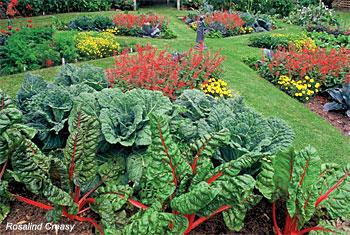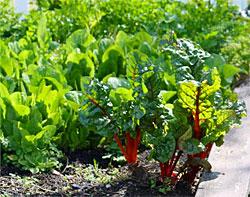Edible landscaping

From a historical perspective, edible landscaping is not new. In fact, some garden styles that we recognize from European landscapes were initially designed for food production. Large park-like lawns were actually communal livestock grazing areas, and borders of tightly clipped hedges encircling planting beds were designed to keep out small farm animals. Over time, the food production aspect of these gardens was replaced with ornamentals, and mowing equipment replaced grazing cattle and sheep.

While the concept of edible landscaping is not new, modern gardening practices based on University of California science-based research and information can make it easier for the home gardener to have a productive and beautiful edible landscape. The process of creating an edible landscape is the same as creating one with purely ornamental features. But by substituting fruits, vegetables, and herbs, where appropriate, for lawn, annuals and perennials, shrubs, and trees, the result is much more functional and sustainable, and good tasting too.
| See the slides that were presented by Sacramento County Master Gardeners at the Edible Landscaping Workshop on March 9, 2013. Please be aware that this PDF file is larger than 13MB so it will take some time to download. |
Resources
Also see other information under the individual topic tabs at the left.
Files below are in PDF format and will open in a new window/tab.
Soils, Amendments and Composting
- EHN 53 - Garden and landscape plantings on hardpan soils
- EHN 54 - Managing clay soil in gardens and landscape plantings
- EHN 55 - Know your soil
- EHN 56 - Improving layered soils for gardens and landscape plantings
- EHN 94 - Sheet mulching
- EHN 98 - Composting for the home gardener
- GN 142 - Composting tips and tricks
- GN 144 - Worm composting
Vegetables
- EHN 96 - Vegetable gardening 101
- ANR 8059 - Vegetable garden basics
- EHN 95 - Growing beets in Sacramento
- EHN 99 - Growing melons in Sacramento
- GN 147 - Tomatoes—suggested varieties for the Sacramento area
- ANR 8159 - Growing tomatoes in the home garden
- GN 109 - Cherry tomatoes
- EHN 15 - Landscaping with herbs
- GN 140 - Vegetable container planting tips
- GN 128 - Understanding information on a seed packet
- GN 154 - Soil temperature conditions for vegetable seed germination
- GN 155 - Growing edible flowers in your garden
Fruit trees
- EHN 85 - Bud grafting
- ANR 8058 - Fruit trees: Pruning overgrown deciduous trees
- ANR 8218 - Citrus bacterial canker disease and Huanglongbing
- ANR 8472 (5.2MB) - Tried and True or Something New? Selected Citrus Varieties for the Home Gardener
Grapes
- EHN 30 - Grapevines—girdling and cluster thinning to increase berry size
- EHN 97 - Guidelines for the home vineyard
Other
- ANR 8499 - Community Gardens
ANR = free publication from the UC Agriculture and Natural Resources Catalog
PN = free publication from UC Integrated Pest Management
EHN = Environmental Horticulture Notes from the UCCE Master Gardeners of Sacramento County
GN = Garden Notes from the UCCE Master Gardeners of Sacramento County
You need Adobe Reader to read the PDF files; download the latest version using the link below.



